Khi công nghệ LED tiếp tục phát triển, các sản phẩm dải LED đã chuyển đổi từ các giải pháp chiếu sáng cơ bản thành nền tảng toàn diện tích hợp hiệu ứng ánh sáng, tính tương tác và trí thông minh. Khi đối mặt với năm loại dải LED chính - một màu, CCT, RGB, RGBW và RGBIC - những người ra quyết định dự án thường cần phải lựa chọn đúng dựa trên các yếu tố như kịch bản ứng dụng, chi phí và kỹ thuật lắp đặt.
Lựa chọn dải đèn LED phù hợp là rất quan trọng để đạt được hiệu ứng ánh sáng tối ưu. Cho dù bạn yêu cầu một giải pháp đơn màu đơn giản hay một thiết lập RGBW hoàn toàn có thể tùy chỉnh, mỗi loại đều cung cấp các tính năng kiểm soát màu sắc, độ sáng và tính linh hoạt ứng dụng riêng biệt.
Trong hướng dẫn này, chúng ta sẽ khám phá sự khác biệt giữa dải đèn LED đơn màu, CCT, RGB, RGBW và RGBIC, nêu chi tiết các chức năng của chúng, các ứng dụng lý tưởng và cân nhắc kỹ thuật.
Đèn dải LED một màu là gì?
Đèn LED đơn màu là loại cơ bản nhất trong chiếu sáng LED, sử dụng chip phát sáng nhiệt độ đơn màu. Nhiệt độ màu thường được sử dụng bao gồm 3000k ánh sáng vàng ấm, 4000k ánh sáng trung tính, và 6000k ánh sáng trắng mát. Những sản phẩm này không có chức năng điều chỉnh màu sắc.
Ưu điểm cốt lõi của nó bao gồm hiệu quả phát sáng cao (lên đến 180 lm / w), tạo nhiệt thấp và tuổi thọ cao (khoảng 50.000 giờ), cùng với việc lắp đặt dễ dàng mà không cần bộ điều khiển. Do thiết kế ổ đĩa điện áp không đổi hoặc điện áp không đổi, nó thường hỗ trợ cắt trong khoảng 2,5–5cm và tương thích với nguồn điện DC12V / 24V tiêu chuẩn.
Chúng chủ yếu được sử dụng trong các ứng dụng chiếu sáng với yêu cầu độ sáng cao, mang lại vẻ ngoài sạch sẽ, chuyên nghiệp và đồng đều khi được lắp đặt trong môi trường trong nhà và bán lẻ. Chúng thường được sử dụng để chiếu sáng công việc trong văn phòng và phòng họp, và ánh sáng đồng nhất của chúng cũng làm cho chúng phù hợp với bảng hiệu và thiết kế nội thất thương mại. Ánh sáng ổn định tăng cường khả năng hiển thị và tập trung.
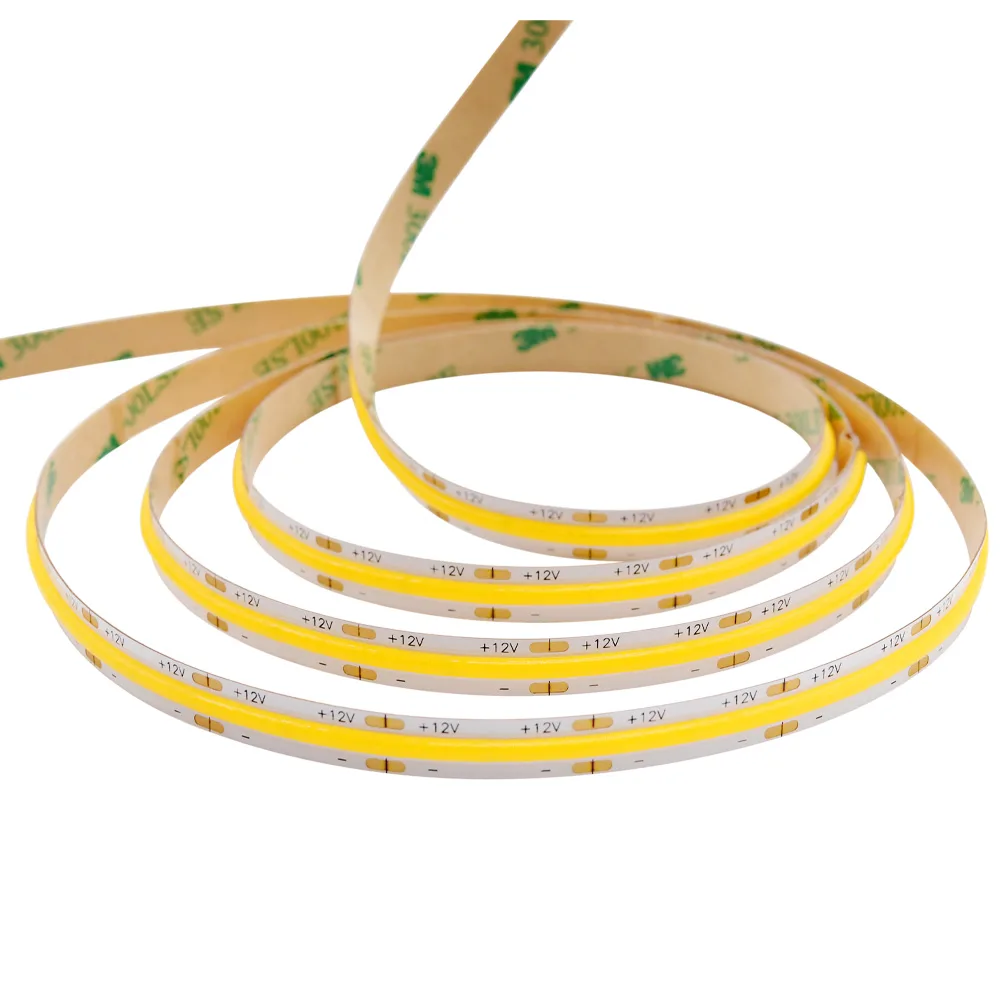
Đèn LED dải màu đơn màu
Mô hình chính: FYX08T480C
Số lượng chip LED trên một mét: 320/384/480/528
CRI: >90
Chiều rộng PCB: 8mm / 10mm
Nhiệt độ màu: 2700k/3000k/4000k/6500k
Điện áp đầu vào: DC12V/DC24V
Công suất trên mét: 8W/10W/11W/14W
Hiệu quả: 130-150lm / W
IP cấp: IP20/IP54/IP65/IP67/IP68
Bảo hành: 3 năm
Đèn LED dải màu trắng có thể điều chỉnh được là gì?

Đèn LED dải màu trắng có thể điều chỉnh được có các chip LED phát ra kép với nguồn sáng màu trắng ấm (2700K) và màu trắng mát (6500K) được bố trí trên dải. Thông qua bộ điều khiển, nó cho phép điều chỉnh nhiệt độ màu liên tục giữa 2700K, 6500K và 4000K (một hỗn hợp 2700K và 6500K). Nói cách khác, bạn có thể đồng thời tận hưởng ánh sáng trắng ấm, ánh sáng trắng tự nhiên và ánh sáng rực rỡ để đáp ứng nhu cầu chiếu sáng của bạn.
Đèn LED dải màu trắng có thể điều chỉnh chủ yếu được sử dụng trong các không gian như phòng ngủ và khu vực văn phòng nơi cần điều chỉnh ánh sáng, cho phép chuyển đổi liền mạch từ môi trường ánh sáng ấm cúng sang môi trường chiếu sáng tập trung.
Khả năng điều chỉnh này làm cho đèn LED CCT lý tưởng cho môi trường yêu cầu ánh sáng thích ứng, chẳng hạn như văn phòng, không gian bán lẻ và môi trường khách sạn, nơi ánh sáng cần chuyển đổi giữa chiếu sáng chức năng và ánh sáng xung quanh. Cho dù tạo ánh sáng tâm trạng, ánh sáng điểm nhấn, ánh sáng nhiệm vụ hay ánh sáng thương mại, đèn dải LED trắng có thể điều chỉnh luôn là một lựa chọn tuyệt vời.
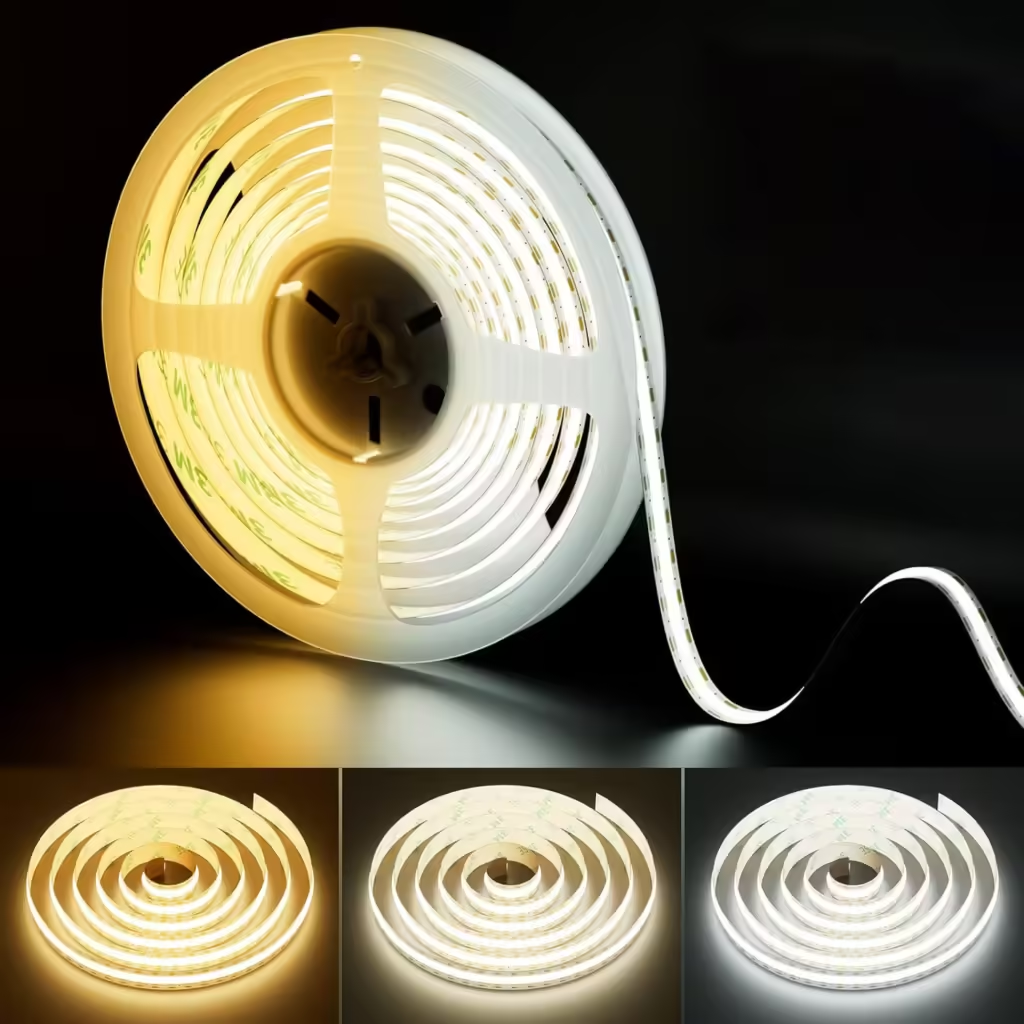
Dải đèn LED màu trắng cob màu trắng
Mô hình chính: FYT10T608C
Số lượng chip LED trên một mét: 608/640
CRI: >90
Chiều rộng PCB: 10mm
Nhiệt độ màu: 2700K - 6500K có thể thay đổi
Điện áp đầu vào: DC12V/DC24V
Công suất trên mét: 608chips - 14W, 640Chips - 16W
Chiều dài có thể cắt: 608Chips - 26.31mm, 640Chip - 50mm
IP cấp: IP20/IP54/IP65/IP67/IP68
Bảo hành: 3 năm
Đèn dải LED RGB là gì?
Một dải đèn LED RGB đề cập đến một dải LED trong đó mỗi đèn LED bao gồm ba chip: đỏ, xanh lá cây và xanh lam. Những con chip này có thể phát ra ánh sáng đơn sắc đỏ, xanh lá cây hoặc xanh dương riêng lẻ hoặc được kết hợp để tạo ra ánh sáng trắng hoặc các màu khác. Khi được ghép nối với bộ điều khiển, chúng có thể đạt được sự kết hợp màu sắc khác nhau và hiệu ứng động.
Đèn LED RGB rất lý tưởng để tạo không khí hoặc ánh sáng tâm trạng, làm cho chúng phù hợp với nhiều không gian thương mại và dân cư, chẳng hạn như cửa hàng bán lẻ, phòng khách, phòng giải trí, phòng ngủ, và thậm chí cả nhà bếp.
Tuy nhiên, trong khi đèn dải LED RGB vượt trội trong việc tạo ra hiệu ứng màu sắc rực rỡ, chúng có những hạn chế khi tạo ra ánh sáng trắng thực sự. Vì ánh sáng trắng được tạo ra bằng cách trộn lẫn đỏ, xanh lá cây và xanh lam, kết quả thường có màu xanh lam hoặc đỏ nhẹ hơn là màu trắng tinh khiết.
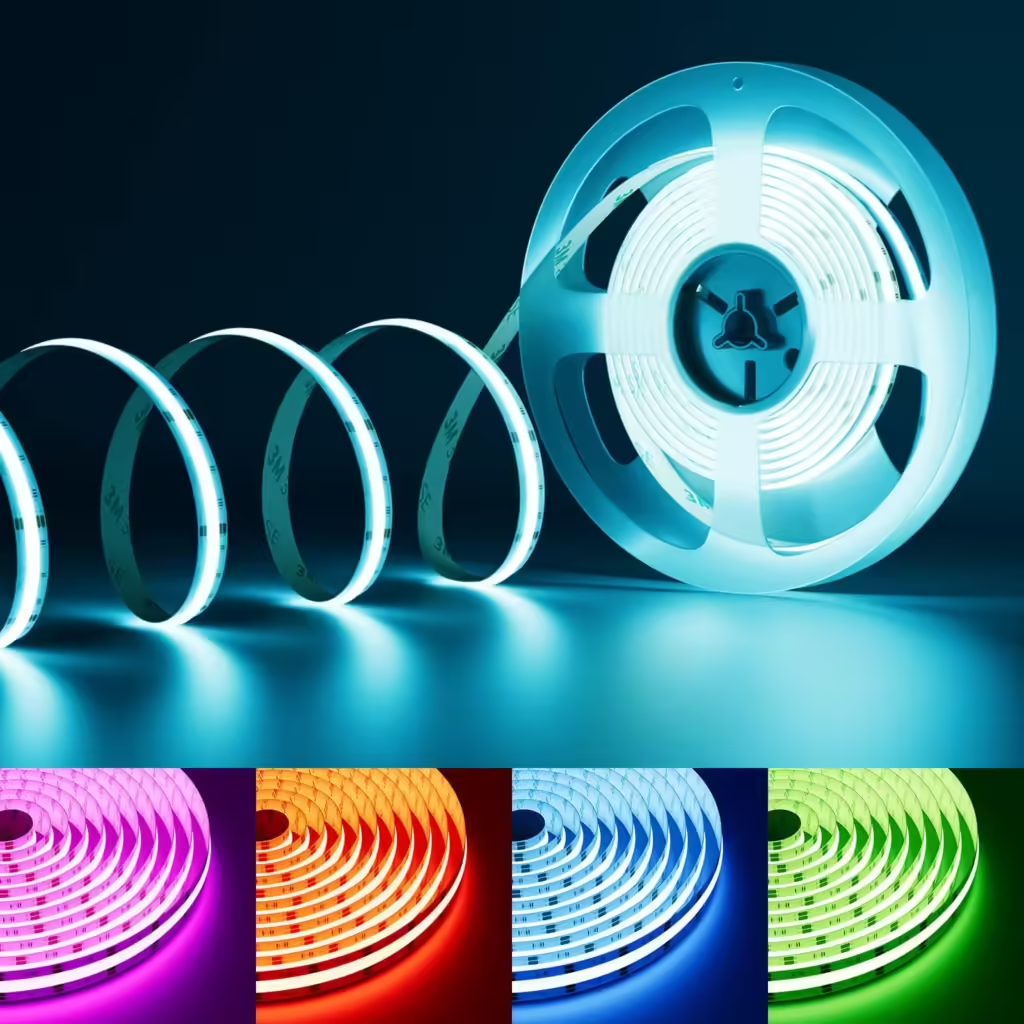
Đèn LED dải màu RGB thay đổi màu sắc
Mô hình chính: FYQ10T576C
Số lượng chip LED trên một mét: 576/810/840
CRI: Không có
Chiều rộng PCB: 10mm
Nhiệt độ màu: rgb
Điện áp đầu vào: DC12V/DC24V
Công suất trên mét: 14W
Chiều dài có thể cắt: 576Chips-31.25mm/62.5mm, 810Chip-33.33mm, 840Chip-50mm
Phiên bản chống nước: IP20/IP54/IP65/IP67/IP68
Bảo hành: 3 năm
Đèn dải LED RGBW là gì?
Đèn LED bốn màu RGBW là sản phẩm chiếu sáng được xây dựng dựa trên dải đèn LED RGB (đỏ, xanh lá cây, xanh dương) truyền thống bằng cách thêm chip LED trắng bổ sung, do đó tạo thành hệ thống pixel bốn màu. Thiết kế này không chỉ giữ lại khả năng kết hợp 16,7 triệu màu của RGB mà còn cho phép đầu ra độc lập của ánh sáng trắng có độ tinh khiết cao, độ sáng cao.
Vì mức tiêu thụ điện của ánh sáng trắng khi được chiếu sáng chỉ bằng 1/3 so với ở chế độ RGB, cấu hình này tăng cường đáng kể độ sáng ánh sáng tổng thể và tối ưu hóa hiệu quả năng lượng ở cùng mức công suất. Người dùng có thể linh hoạt chuyển đổi giữa ánh sáng trắng đơn sắc, ánh sáng ấm áp, hoặc hiệu ứng trộn màu RGB động thông qua bộ điều khiển, đạt được sự chuyển đổi liền mạch từ ánh sáng thực tế sang màu sắc rực rỡ.
Dải ánh sáng RGBW đắt hơn khoảng 25% so với dải đèn RGB. Các dải này lý tưởng cho các dự án chiếu sáng kiến trúc, chẳng hạn như chiếu sáng mặt tiền khách sạn và các ứng dụng cửa hàng bán lẻ. Chúng có thể dễ dàng chuyển từ ánh sáng trắng sang hiệu ứng màu sắc động, giúp chúng hoàn hảo để thu hút sự chú ý và nâng cao khả năng hiển thị thương hiệu.
Vì dải LED RGBW không dựa vào việc trộn các mức RGB để tạo ra ánh sáng trắng, chúng lý tưởng cho các ứng dụng yêu cầu ánh sáng cân bằng, tự nhiên và chất lượng cao.
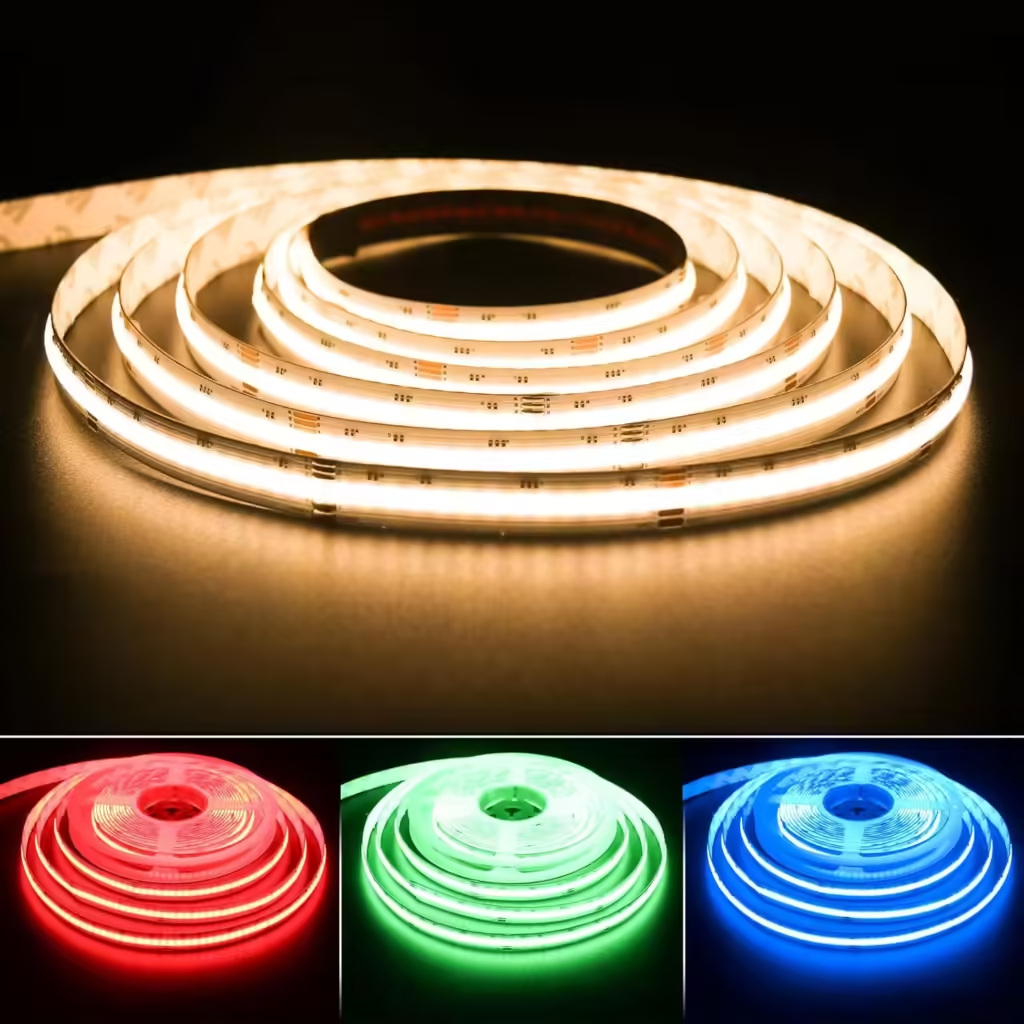
Thay đổi màu sắc RGBW COB dải đèn LED
Mô hình chính: FYH12T784C
Số lượng chip LED trên một mét: 784
CRI: Không có
Chiều rộng PCB: 12mm
Nhiệt độ màu: RGBW
Điện áp đầu vào: DC24V
Công suất trên mét: 19W
Chiều dài có thể cắt: 71,42mm
Phiên bản chống nước: IP20/IP54/IP65/IP67/IP68
Bảo hành: 3 năm
Đèn dải LED RGBIC là gì?
Dải LED RGBIC là dải LED điều khiển pixel, còn được gọi là dải LED thông minh. Chúng được phân loại thành hai loại dựa trên cấu trúc kết hợp của IC và chip LED: tích hợp và bên ngoài. Trong loại tích hợp, chip vi điều khiển (IC) được nhúng trong mỗi chip LED, với IC điều khiển bên trong chế độ chiếu sáng của chip RGB. Cấu hình này giúp tiết kiệm không gian thành phần, giảm hệ thống dây điện phức tạp và rút ngắn thời gian thiết kế kỹ thuật.
Các dải ánh sáng IC bên trong hỗ trợ địa chỉ độc lập: Mỗi đèn LED có thể nhận được hướng dẫn thông qua IC bên trong và được điều khiển riêng theo màu sắc, độ sáng hoặc trạng thái bật / tắt, cho phép lập trình LED đơn. Chúng chỉ yêu cầu một dây tín hiệu duy nhất để điều khiển một chuỗi đèn LED dài, giúp hệ thống dây điện trở nên đơn giản.

Dải ánh sáng IC ngoài IC tách chip RGB ra khỏi chip điều khiển, dùng IC để điều khiển các đèn LED RGB. Ưu điểm của phương pháp này là các đèn LED được tách ra khỏi IC, cải thiện khả năng tản nhiệt. Tuy nhiên, nó có nhiều thành phần bên ngoài hơn và một mạch điều khiển phức tạp hơn. Như thể hiện trong sơ đồ sau đây: Sử dụng chip WS2811 bên ngoài với bộ điều khiển giao thức SPI / DMX512 để đạt được các hiệu ứng động như độ dốc cầu vồng và các mẫu ánh sáng chảy.

Dải LED RGBIC tương thích với các bảng phát triển như Arduino và Raspberry Pi, cho phép các phản hồi có thể lập trình được với âm nhạc, cảm biến hoặc lệnh IoT. Chúng là một lựa chọn lý tưởng cho các ứng dụng chiếu sáng động, với các IC bên ngoài hỗ trợ các hiệu ứng phức tạp ở mức pixel như cuộn văn bản, hiển thị hình ảnh và hiệu ứng đuổi theo dòng chảy, cạnh tranh với màn hình độ phân giải thấp.
Đèn LED RGBIC phù hợp cho các sân khấu, tường nghệ thuật kỹ thuật số, cài đặt video tùy chỉnh, mặt tiền xây dựng, lắp đặt nghệ thuật tương tác và các kịch bản khác đòi hỏi hiệu ứng ánh sáng động có độ chính xác cao. Chúng đóng vai trò là nền tảng công nghệ quan trọng cho chiếu sáng thông minh. Các ứng dụng phổ biến bao gồm địa điểm giải trí, ánh sáng sân khấu, trang trí ngày lễ và cài đặt tương tác. Họ có thể tạo hình ảnh động, hiệu ứng và mẫu tùy chỉnh, làm cho chúng phổ biến trong các màn hình chiếu sáng sáng tạo như quán bar, câu lạc bộ hoặc sắp đặt nghệ thuật.
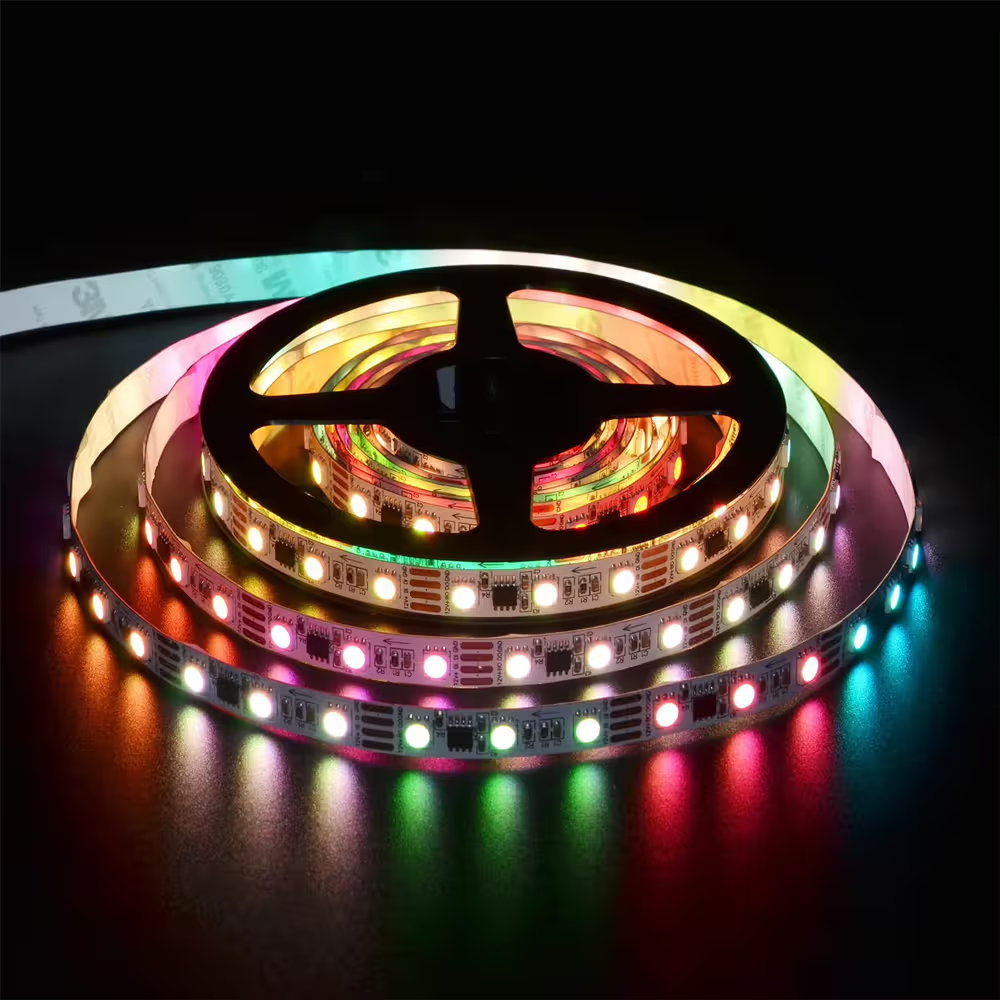
Đèn LED dải đèn LED RGBIC
Mô hình chính: Fax10t60a
Loại LED: SMD5050
Số lượng đèn LED trên một mét: 30/32/60/72/84/96/120/144
Chiều rộng PCB: 8mm/10mm/12mm/14mm
Nhiệt độ màu: 2700K-6500K / RGB / RGBW / RGBCCT
Điện áp đầu vào: DC5V/DC12V/DC24V
Công suất trên mét: 6W/10W/12W/14W/18W/19W/20W/22W
IP cấp: IP20/IP65/IP67/IP68
Bảo hành: 3 năm
Phía trên chức năng hỗ trợ tùy biến.
Khuyến nghị ứng dụng ánh sáng dải LED
1Chiếu sáng dân cư: khuyến nghị chữ của anhse of tôionochrome LED chữ thứ 19chuyến
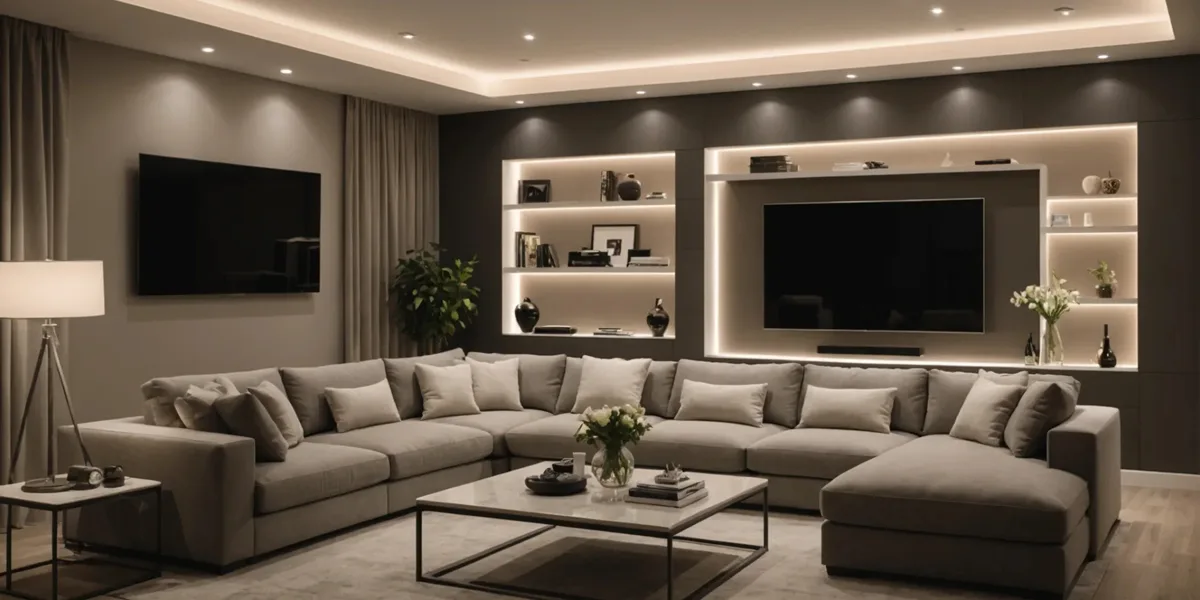
Đối với các không gian như phòng khách, phòng ngủ, hành lang, nhà bếp, phòng tắm và tủ dưới, dải đèn LED đơn sắc mang lại những lợi thế sau:
- Ánh sáng ổn định và thoải mái: nhiệt độ màu cố định, chẳng hạn như ánh sáng vàng 2700K hoặc ánh sáng trung tính 4000K; ánh sáng đồng đều và nhẹ với chỉ số kết xuất màu cao, giảm mỏi mắt trong thời gian dài sử dụng, đặc biệt thích hợp cho người già và trẻ em.
- Hoạt động đơn giản và độ bền: Không cần chuyển đổi phức tạp; một nút nhấn đáp ứng nhu cầu ánh sáng cơ bản. Cấu trúc mạch đơn giản với tỷ lệ hỏng hóc thấp hơn 30% so với dải ba màu. Tuổi thọ chip LED dài và chi phí bảo trì thấp.
- Hiệu quả chi phí cao: Giá thấp hơn 20%-30% so với dải ánh sáng ba màu và không cần bộ điều khiển bổ sung hoặc thiết bị thông minh, khiến chúng trở nên lý tưởng cho các hộ gia đình có ngân sách hạn chế.
2Ánh sáng lành mạnh: Chúng tôi khuyên bạn nên sử dụng dải LED trắng có thể điều chỉnh
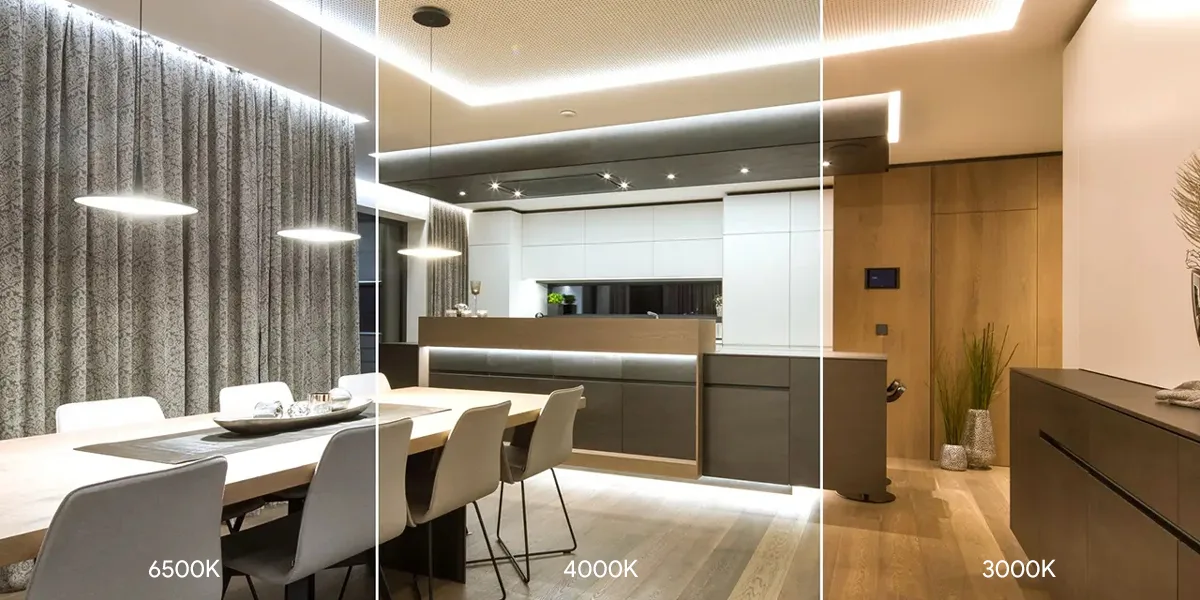
Khuyến nghị này dựa trên tối ưu hóa khoa học của chúng cho nhịp sinh học, sự thoải mái về thị giác và khả năng thích ứng với môi trường, làm cho chúng trở nên lý tưởng cho các thiết lập như nhà hàng, phòng học, không gian bán lẻ, khách sạn và khu vực ăn uống.
- Điều chỉnh nhiệt độ màu: Dải ánh sáng hai màu có thể tự động chuyển đổi nhiệt độ màu (ví dụ: 2700K – 6500K). Nhiệt độ màu cao hơn trên 5000K trong ngày giúp tăng cường sự tỉnh táo, trong khi nhiệt độ màu thấp hơn từ 2700K đến 3000K vào ban đêm thúc đẩy tiết melatonin và cải thiện chất lượng giấc ngủ.
- Giảm mỏi mắt: Chỉ số kết xuất màu cao (RA ≥ 90) và thiết kế ánh sáng xanh thấp tái tạo chính xác màu sắc đối tượng và giảm sự khác biệt màu sắc; chuyển đổi nhiệt độ màu tránh tiếp xúc lâu với nguồn sáng duy nhất, làm cho nó đặc biệt phù hợp cho việc đọc của học sinh hoặc môi trường văn phòng.
- điều tiết tâm trạng: Chế độ ánh sáng ấm và mát có thể chuyển đổi, chẳng hạn như ánh sáng ấm áp cho không gian ấm cúng trong phòng khách trong khi xem phim và ánh sáng mát mẻ để tăng cường khả năng tập trung trong phòng học, đáp ứng nhu cầu của không gian đa chức năng.
- Hỗ trợ y tế cấp y tếT: Nhiệt độ màu từ 2700K đến 3000K giúp ức chế sự phát triển của trục mắt quá mức và giảm nguy cơ bị cận thị; nhiệt độ màu từ 4000K đến 5000K phù hợp cho việc học tập, giảm mỏi mắt.
- Tiết kiệm năng lượng và làm mờ thông minh: So với dải đèn một màu, thiết kế hai màu bao gồm tất cả các tình huống mà không cần thiết bị chiếu sáng bổ sung và có thể được liên kết với các hệ thống thông minh để làm mờ tự động, tăng cường khả năng sử dụng.
Nên chọn các sản phẩm chiếu sáng sức khỏe chuyên nghiệp hỗ trợ hoạt động không nhấp nháy và độ màu cao và tránh tiếp xúc quá nhiều với ánh sáng xanh nhiệt độ cao vào ban đêm.
3. Giải trí thương mại: Khuyến cáo sử dụng dải đèn RGB
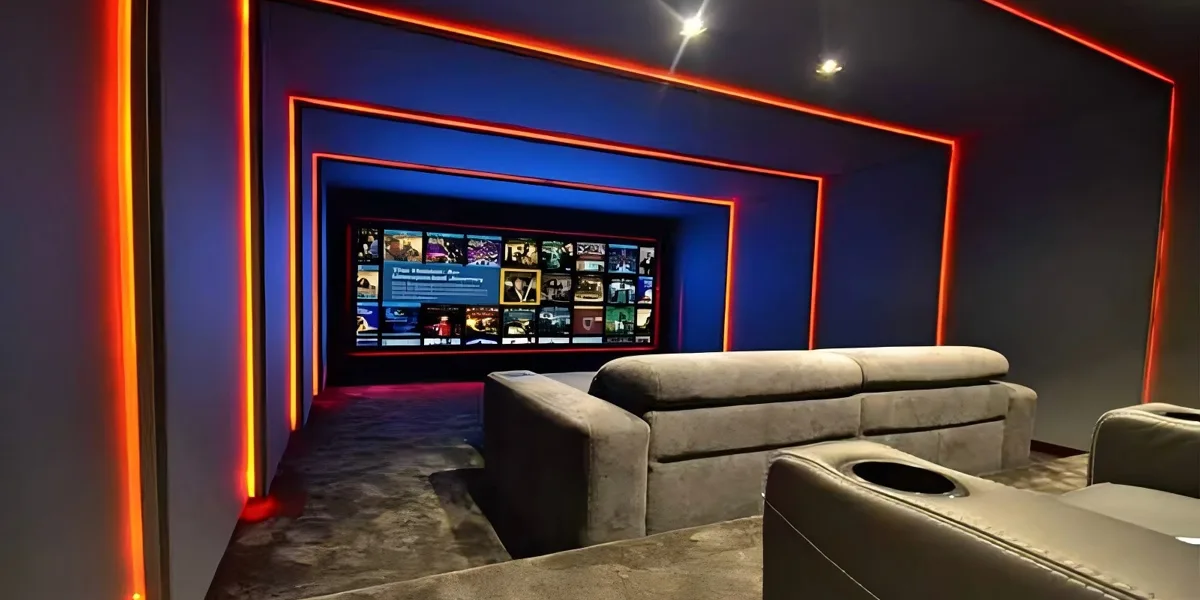
Chủ yếu là do lợi thế độc đáo của chúng về màu sắc, hiệu ứng động và khả năng thích ứng cảnh, chúng phù hợp để thiết lập tâm trạng hoặc ánh sáng cảm xúc. Ví dụ, thanh, KTV, tường nền TV, tủ trưng bày và các khu vực khác có yêu cầu chiếu sáng không chính xác.
- Màu sắc đa dạng: Dải ánh sáng RGB có thể kết hợp ba màu chính - đỏ, xanh lá cây và xanh lam - để tạo ra 16,7 triệu kết hợp màu, dễ dàng chuyển đổi giữa ánh sáng ấm áp lãng mạn và ánh sáng mát mẻ lấy cảm hứng từ công nghệ để đáp ứng nhu cầu cá nhân của các thiết lập thương mại khác nhau. Ví dụ, các thanh có thể đồng bộ màu động với nhịp điệu âm nhạc để tăng cường sự đắm chìm, trong khi các cửa hàng bán lẻ có thể sử dụng ánh sáng gradient mềm để làm nổi bật chất lượng sản phẩm.
- Hiệu ứng động: Hỗ trợ đồng bộ hóa với âm nhạc, video hoặc hệ thống thông minh để tạo ra các hiệu ứng động như nước chảy hoặc thở, tăng cường đáng kể sức sống không gian. Ví dụ, dải đèn RGB tại các lối vào phòng triển lãm có thể tự động chuyển đổi chế độ dựa trên lưu lượng truy cập đi bộ, tạo điểm nhấn trực quan.
- mềm dẻo Và giá thấp: Dải ánh sáng linh hoạt và có thể uốn cong, phù hợp với các cấu trúc không đều (như quầy hoặc đường viền trần), và dễ dàng lắp đặt.
- Hiệu quả năng lượng. Tuổi thọ cao: Nguồn sáng LED có mức tiêu thụ điện năng thấp và tuổi thọ cao (trên 50.000 giờ), dẫn đến chi phí sử dụng lâu dài thấp hơn so với các thiết bị chiếu sáng truyền thống, phù hợp với yêu cầu tiết kiệm năng lượng cho không gian thương mại.
4thuộc về thương m nốt thứ sáu trongMBIance: dải ánh sáng RGBW được khuyến khích
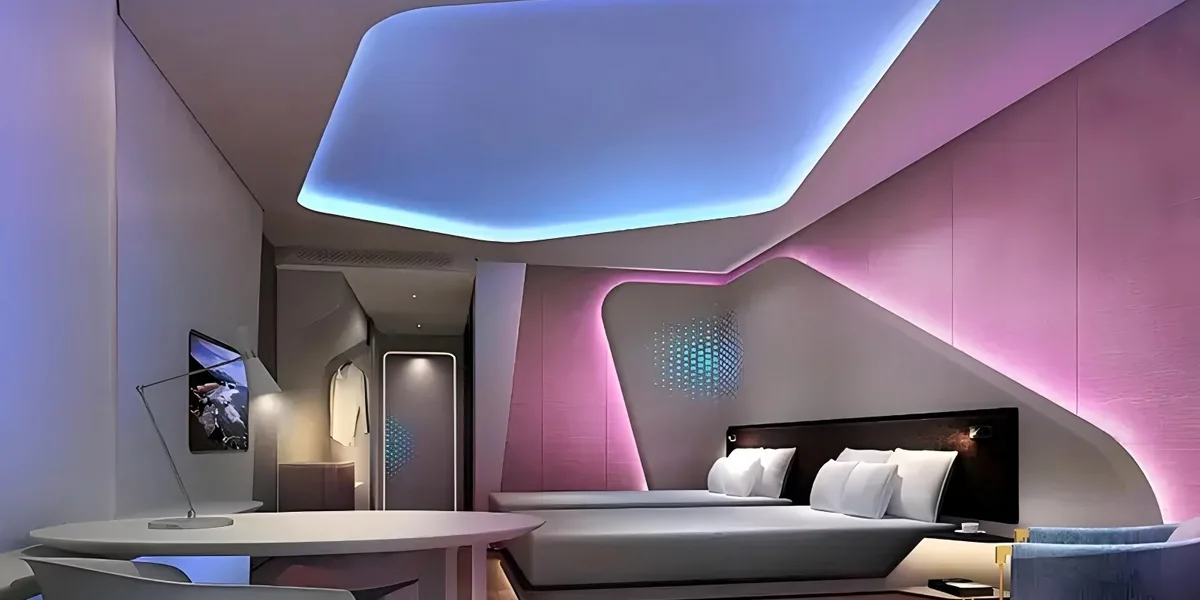
Chủ yếu là do lợi thế đáng kể của chúng về hiệu suất màu sắc, khả năng thích ứng với môi trường và kiểm soát thông minh. Ví dụ: mặt tiền cửa hàng, quầy trang sức và ánh sáng tòa nhà yêu cầu ánh sáng kết xuất màu cao cân bằng giữa hiệu suất màu sắc và yêu cầu độ sáng.
- Khả năng pha màu tiên tiến: Dải ánh sáng RGBW kết hợp màu đỏ (R), xanh lá cây (G), xanh lam (B) và ánh sáng trắng (W) để tạo ra màu sắc mềm mại, trông tự nhiên, tránh màu sắc rực rỡ của dải ánh sáng RGB truyền thống. Điều này làm cho chúng lý tưởng để tạo ra một không gian thương mại thanh lịch, mềm mại.
- Hiệu ứng động và thích ứng cảnh: Hỗ trợ điều khiển thông minh, cho phép đồng bộ hóa với âm nhạc hoặc ứng dụng để đạt được độ dốc, dòng chảy và các hiệu ứng động khác, phù hợp cho các tình huống yêu cầu tập trung trực quan, chẳng hạn như triển lãm hoặc cửa sổ lưu trữ. Ví dụ, trong các buổi biểu diễn thương mại, việc đồng bộ các dải ánh sáng với âm nhạc giúp tăng cường sự đắm chìm.
- dể uốn lớnbuổi chiều tôibài thơ ngắn để hát chữ thứ 19sự dùng trên mặt: Chức năng điều khiển ánh sáng trắng độc lập (như 6500K ánh sáng mát hoặc 3000K ánh sáng ấm) đáp ứng nhu cầu chiếu sáng cơ bản, trong khi chế độ RGB nhanh chóng chuyển sang ánh sáng xung quanh, cân bằng tính thực tế và hấp dẫn trang trí.
5. Nghệ thuật kỹ thuật số: Chúng tôi khuyên bạn nên sử dụng dải ánh sáng RGBIC
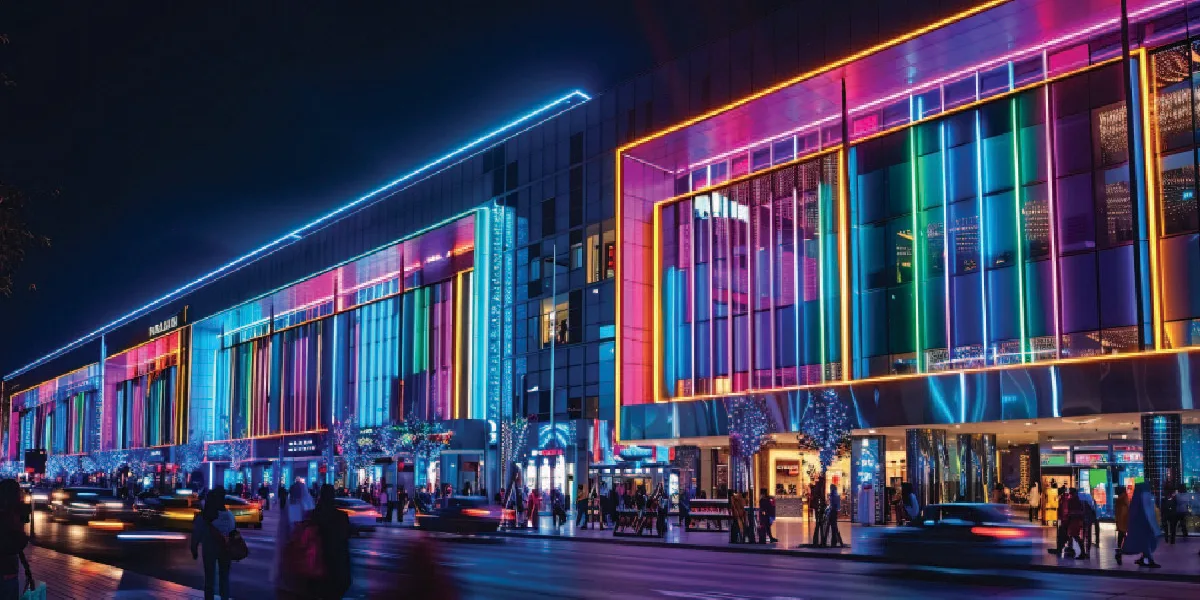
Chủ yếu là do lợi thế độc đáo của chúng trong hiệu suất màu sắc, điều khiển động và khả năng tương tác nghệ thuật. Ví dụ, ở các địa điểm như sân khấu, phòng triển lãm, phòng thể thao điện tử và các tác phẩm sắp đặt nghệ thuật yêu cầu ánh sáng động có độ chính xác cao, chúng có thể được đồng bộ hóa với âm nhạc và cảm biến để đạt được trải nghiệm tương tác tuyệt vời.
- Độ chính xác màu cực cao và hiệu ứng động: Dải ánh sáng RGBIC, chẳng hạn như chip WS2812B / SK9822, hỗ trợ địa chỉ độc lập của mỗi đèn LED, đạt được độ sâu 16 triệu màu (16 bit / kênh), vượt xa độ sâu màu 8 bit của dải đèn RGB truyền thống. Kết hợp với công nghệ làm mờ PWM, chúng có thể đạt được độ dốc mượt mà, hiệu ứng chảy, hiệu ứng thở và các hiệu ứng ánh sáng động khác, đáp ứng nhu cầu cực cao của nghệ thuật sắp đặt để chuyển đổi màu sắc.
- Điều khiển và lập trình chính xác: Chip IC tích hợp cho phép lập trình thông qua các giao thức SPI/UART, hỗ trợ các hệ thống điều khiển như Arduino và DMX, cho phép tương tác thời gian thực giữa ánh sáng, âm thanh, cảm biến hoặc chuyển động của khán giả (ví dụ: nhịp điệu âm nhạc, kích hoạt cảm ứng). Ví dụ, cài đặt có thể tạo ra các hiệu ứng ánh sáng động bằng cách sử dụng thuật toán AI để tăng cường sự đắm chìm.
- Tính linh hoạt và khả năng thích ứng: Sử dụng kiến trúc xếp tầng nối tiếp, một dải ánh sáng đơn có thể xếp tầng lên đến 100 mét (có khuếch đại tín hiệu), phù hợp cho các lắp đặt quy mô lớn.
- Hiệu suất bảo vệ: Thiết kế chống nước IP68 (ống silicon + quá trình bầu) cho phép sử dụng trong môi trường ngoài trời hoặc ẩm ướt.
So sánh tính năng kỹ thuật cốt lõi
Dải LED đơn sắc (4000K Pure White) mang lại hiệu quả chi phí tốt nhất, với chi phí cho mỗi mét dưới $1.5, lý tưởng cho việc lưu kho và hậu cần. Dải đèn LED CCT cung cấp ánh sáng nhịp sinh học từ 2700K đến 6500K, với chỉ số kết xuất màu (CRI) trên 95, phù hợp cho các cơ sở y tế và giáo dục; dải ánh sáng RGBW cho ánh sáng sản phẩm, có ánh sáng trắng CRI 90 cộng với màu sắc năng động để thu hút lưu lượng truy cập, phù hợp cho các cửa hàng bán lẻ. RGBIC điều khiển kỹ thuật số cho ánh sáng màu chảy, thích hợp cho khách sạn, câu lạc bộ và xây dựng mặt tiền truyền thông.
Bảng so sánh tính năng kỹ thuật cốt lõi
| Loại kiểm soát | Kích thước màu | Giao thức / chip điển hình | Chỉ số hiển thị màu (CRI) | Tỷ lệ hiệu suất năng lượng (W/m) | Bộ điều khiển tối thiểu |
| chỉ có một sắc | Nhiệt độ màu cố định | IC dòng điện không đổi (ví dụ, PT4115) | ≥90 | 4.8-14.4 | Toàn bộ dải ánh sáng |
| CĐT | 2700K-6500K | PWM Dưỡng Độn Hai Kênh | ≥90 | 7.2-19.2 | đoạn 1 mét |
| rgb | 16 triệu màu | WS2812B/SK6812 | 65-75 | 14.4-28.8 | đèn LED đơn |
| RGBW | RGB + ánh sáng trắng tinh khiết | SK6812RGBW | ≥90 | 18-36 | đèn LED đơn |
| thuộc về nước Rgbic | Địa chỉ độc lập | DMX512/ArtNet | phụ thuộc vào chip | 24-72 | điểm pixel đơn |
Ghi chú cài đặt
1. Tránh sử dụng RGB làm nguồn chiếu sáng chính, vì màu RGB không phù hợp với mục đích chiếu sáng. Ngoài ra, chỉ số kết xuất màu (CRI) của ánh sáng hỗn hợp là dưới 70, vì vậy nó chỉ phù hợp cho các ứng dụng giải trí thương mại.
2 .Khi khoảng cách truyền quá dài, các dự án điều khiển điểm ảnh phải kết hợp bộ khuếch đại dữ liệu. Cân nhắc cụ thể nên dựa trên điện áp đầu vào và khoảng cách.
3. Trong môi trường ẩm ướt, chọn dải LED có xếp hạng IP65 trở lên.
4. Dải LED RGBIC Pixel có quá trình cài đặt phức tạp hơn, đòi hỏi phải có cáp dữ liệu được cài đặt sẵn để điều khiển điểm ảnh, dẫn đến chi phí nhân công tăng lên 40%.
6. Phương pháp tản nhiệt: Để tiêu thụ điện năng dưới 14 W / mét, làm mát đối lưu tự nhiên là đủ. Đối với mức tiêu thụ điện năng vượt quá 24 W / mét, cần phải làm mát bằng không khí cưỡng bức bằng các kênh nhôm.
Bản tóm tắt
Lựa chọn đúng Dải đèn LED là chìa khóa để đạt được hiệu ứng ánh sáng bạn muốn cho dự án của mình. Xác định mục đích của ánh sáng — cho dù đó là hiệu ứng trang trí, ánh sáng chung hay sử dụng chuyên nghiệp.
Đèn dải đơn sắc là lý tưởng để tạo ra một bầu không khí nhất quán, chẳng hạn như ánh sáng trắng ấm áp hoặc mát mẻ, và hoàn hảo cho ánh sáng nhiệm vụ hoặc ánh sáng điểm nhấn trong nhà và văn phòng; Dải ánh sáng CCT mô phỏng ánh sáng tự nhiên với độ dốc màu từ 2700K đến 6500K, trong khi dải đèn LED RGB cung cấp màn hình màu động và khả năng tạo hiệu ứng ánh sáng khác nhau.
Các dải ánh sáng RGBW truyền ánh sáng trắng vào bảng màu và các dải ánh sáng được điều khiển bằng pixel cho phép mỗi điểm ánh sáng hoạt động như một bàn chải kỹ thuật số có thể lập trình, vẽ nên màu sắc trong trí tưởng tượng của bạn.
FAQ
a: W - Ánh sáng trắng; CW - Ánh sáng trắng và ánh sáng trắng ấm; CCT (Nhiệt độ màu tương quan) - Trắng lạnh (CW) và Trắng ấm; IC - Mạch tích hợp.
a: RGBW thêm một bộ ánh sáng trắng vào ba màu RGB.
a: Mặc dù việc trộn các loại dải đèn LED khác nhau về mặt kỹ thuật là có thể, nhưng các loại chip khác nhau có mức đầu ra và độ sáng khác nhau, và việc trộn chúng có thể dẫn đến hiệu ứng không đồng đều hoặc không nhất quán. Chỉ nên sử dụng một loại đèn LED cho mỗi cài đặt; nếu bạn chọn trộn đèn LED, hãy đảm bảo chúng tương thích với bộ điều khiển của bạn và xem xét sự khác biệt về hiệu suất của chúng để duy trì ánh sáng nhất quán.
a: Tất cả các dải đèn LED pixel có thể được cắt tại các khớp hàn. Nó rất đơn giản và dễ dàng.
a: Dải LED cao áp, chẳng hạn như 24V hoặc 48V, có thể hoạt động trên khoảng cách xa hơn mà không bị sụt áp. Bằng cách giảm dòng điện, chúng giảm thiểu điện trở, cho phép độ sáng ổn định trong thời gian chạy dài hơn.
a: Chớp mắt thường do điện áp giảm hoặc nguồn điện không đủ. Kiểm tra xem nguồn điện của bạn có đủ nguồn để điều khiển dải được kết nối hay không và đảm bảo độ dài dây là hợp lý.
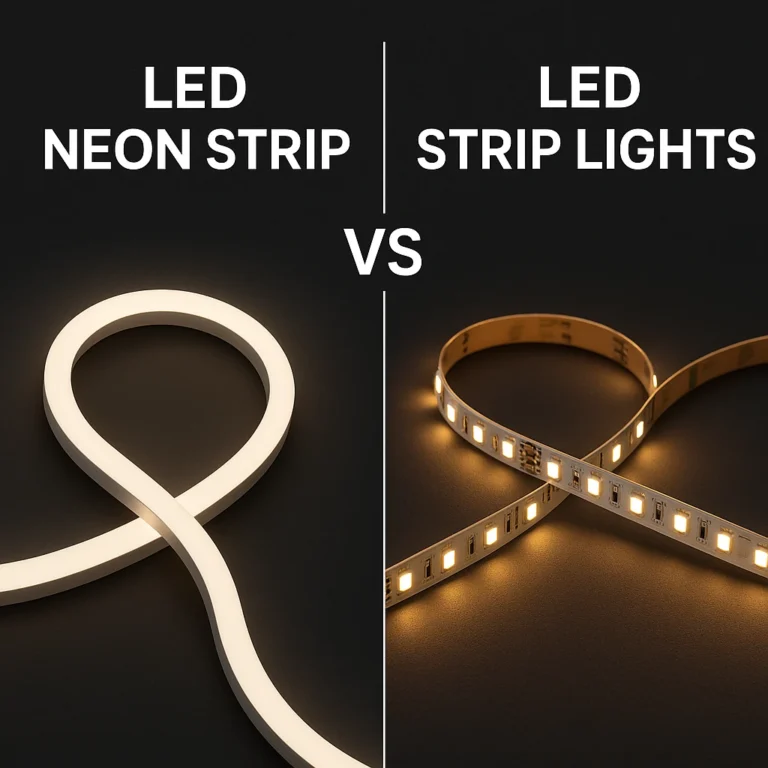

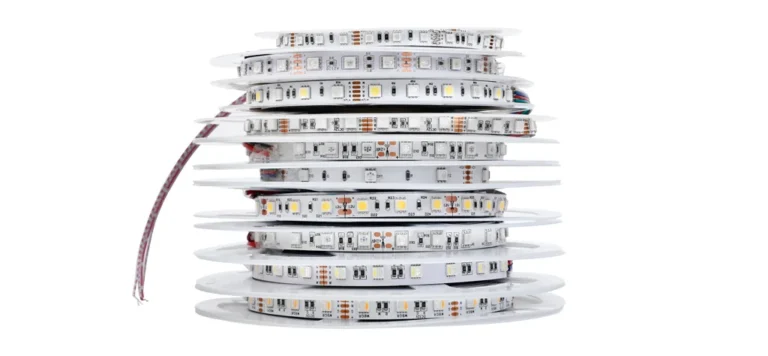
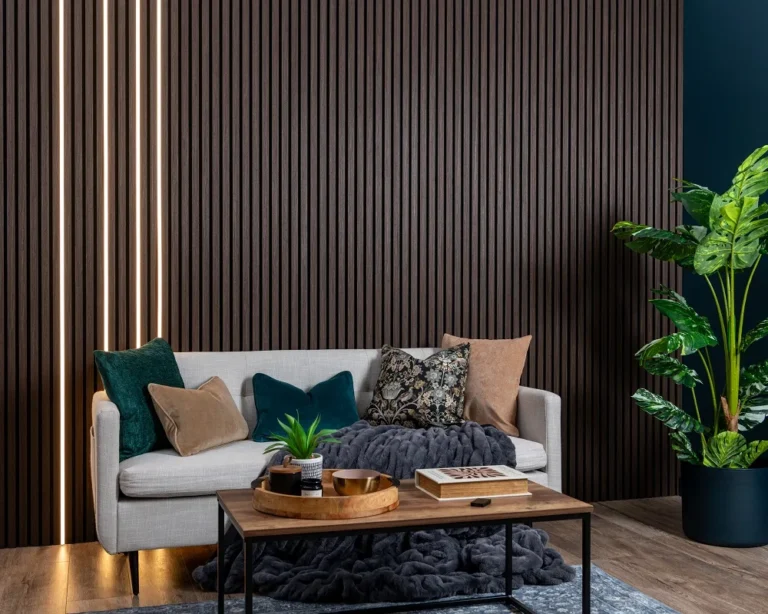
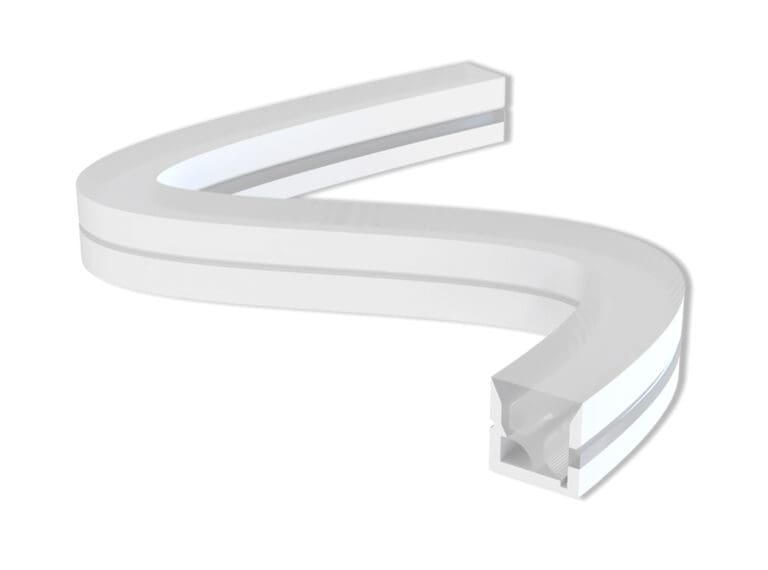
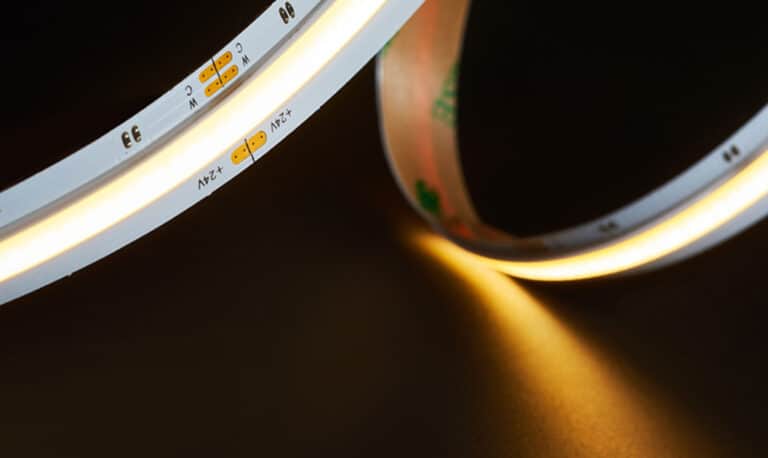

Bài viết của bạn có một cách cộng hưởng với tôi ở mức độ sâu sắc. Tôi đánh giá cao sự trung thực và chân thực mà bạn mang lại cho mỗi bài đăng. Cảm ơn bạn đã chia sẻ hành trình của bạn với chúng tôi.
thường tôi không đọc bài báo trên blog tuy nhiên tôi muốn nói rằng bài viết này rất buộc tôi phải xem và làm vì vậy sở thích viết của bạn đã làm tôi ngạc nhiên, cảm ơn bài viết khá hay
Về cơ bản, ai đó giúp tạo ra các bài báo đáng kể id trạng thái Đây là lần đầu tiên tôi thường xuyên truy cập trang web của bạn và cho đến bây giờ tôi đã ngạc nhiên với nghiên cứu mà bạn đã thực hiện để thực hiện bài đăng thực tế này, công việc tuyệt vời đáng kinh ngạc
Blog của bạn giống như một ngọn đèn ánh sáng trong phạm vi rộng lớn của Internet. Phân tích chu đáo và bình luận sâu sắc của bạn không bao giờ không để lại ấn tượng lâu dài. Cảm ơn bạn vì tất cả những gì bạn làm.